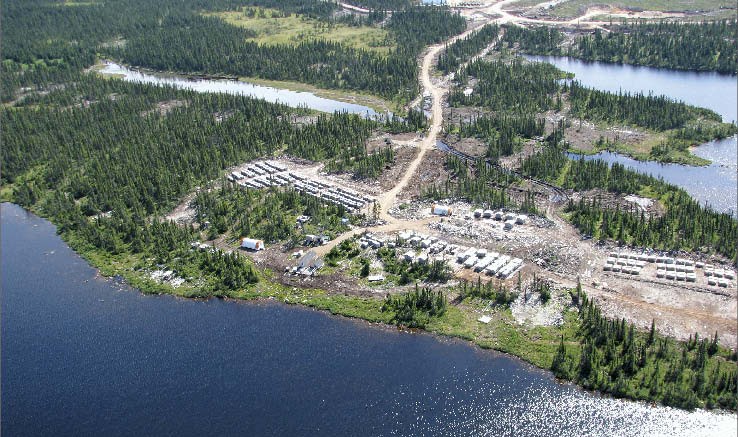Three years, millions of dollars, and thousands of pages of impact studies later, there is still no guarantee that Strateco Resources (RSC-T) will be allowed to explore underground on its Matoush uranium project in northern Quebec’s Otish mountains.
But that reality has not curbed the enthusiasm of Strateco president and CEO Guy Hébert.
On a short breather between investor meetings in Europe and the United States, Hébert says he feels confident that the company will be granted the licence it needs to begin underground work on Matoush this summer. In fact, Strateco is so confident that the company has built a $7-million airstrip, increased the size of the camp, and is moving supplies for development up the winter road.
“We expect a positive recommendation (from the federal and provincial review panels) because we have strong support from all seven mayors of municipalities in the James Bay area,” Hébert says. Even the Parti Québécois, the provincial opposition party that supported a moratorium on exploration last year, recently agreed that uranium projects should be evaluated on a case-by-case basis, he says.
Last December, Strateco received a vote of confidence from the market with the closure of a $13-million bought-deal financing that will be used to further explore and develop Matoush and nearby properties. Ned Goodman, CEO of the lead underwriter on the financing, Dundee Securities Corp., owned 400,000 shares of the company as of mid-December.
A rising uranium oxide price has helped lift the value of Strateco shares from 50¢ last September to as much as $1.30 in early February. Over the same period, uranium oxide climbed 50% to US$75 per lb. as demand began to outstrip supply.
If Strateco gets the go-ahead from regulators, the underground exploration licence would be the first of its kind in Quebec, where uranium mining is unprecedented and there is strong resistance to exploration for the radioactive metal.
Last year, three petitions with 14,000 signatures were presented to Quebec’s National Assembly demanding a moratorium on uranium exploration and mining in the province.
However, the Liberal government dismissed the public outcry, concluding that a moratorium would be “unjustified.”
It was April 2008 when Strateco first notified the Canadian Nuclear Safety Commission (CNSC) and the Quebec government that it wished to secure the permits required for underground exploration work. Strateco planned to start the work, consisting of site preparation and excavation of an access ramp to the 300-metre level and drifts for exploration, in mid-2009.
But the permitting “journey” has been long and arduous, says Hébert, who has brought three mines into production in his lifetime. “I have had a lot experiences in my life, but this one is very special,” he says.
After spending roughly $12 million to secure the licence, Strateco presented an 8,000-page environmental impact assessment (EIA) to the communities of Mistassini and Chibougamau in May 2010. Public hearings followed in November. At presstime, the federal and provincial review committees were weighing the differing views on the project before making recommendations.
Hébert says the hearings went smoothly in Chibougamau where there is local support for the project and the dialogue was in French. But the English hearings in Mistassini were more “rock and roll” as Strateco faced opposition from the Cree Regional Health Authority and Canada-wide non-governmental organizations including MiningWatch Canada, the Canadian Coalition for Nuclear Responsibility, Canadian Parks and Wilderness Society, and the Quebec Network of Environmental Organizations.
“With everything that’s in front of them, I don’t see how the review committees could recommend approval,” said Ramsey Hart, Canada program coordinator of MiningWatch, in a statement. He sees serious flaws in Strateco’s EIA, namely the failure to address how the 2.4-km underground ramp would interact with groundwater, and a lack of information about the proposed mine.
But Strateco is forging ahead with surface exploration regardless. The first phase of the 2011 program, consisting of 30,000 metres of drilling, is underway with two rigs. The program will further investigate the 100%-owned Matoush property, the Mistassini property, where the junior is earning a 60% interest from Majescor Resources (MJX-V) and the Pacific Bay-Matoush property, where Strateco is earning a 60% interest from Pacific Bay Minerals (PBM-V).
On Matoush, Strateco is targeting the MT-36 lens, which is situated 1.5 km south of the main resource, where last year’s drilling cut 0.48% U3O8 over 4.2 metres and 0.33% U3O8 over 5.1 metres. The lens has been traced over a distance of 300 metres and this year’s drilling will allow Strateco to
calculate a National Instrument 43-101 compliant resource for it.
About 50 km southwest of Matoush, a 1,000-metre program will test results from a 2009 program on Majescor’s Mistassini property that uncovered a new uranium-bearing zone at surface. The program will confirm the continuity of the zone, which returned values of up to 0.21% U3O8 over 11.6 metres.
And 4 km west of the Matoush fault that hosts the main deposit, a 5,500-metre program will test the Alfred fault on Pacific Bay’s property, where there are strong indications of uranium-related alteration similar to that encountered at Matoush.
Matoush is the most advanced uranium exploration project in Eastern Canada. As of late 2009, indicated resources are 436,000 tonnes grading 0.78% U3O8 containing 7.46 million lbs. U3O8, while inferred resources are estimated at 1.16 million tonnes of 0.50% U3O8 containing 12.78 million lbs. U3O8.
Over a seven-year mine life and at an estimated $341-million capital cost, the deposit would produce more than 2 million lbs. U3O8 per year for an internal rate of return before taxes of 41.5%.
No wonder Hébert is not giving up.
– The author is a freelance writer specializing in mining issues, and principal of Toronto-based GeoPen Communications, www.geopen.com.


Be the first to comment on "Strateco forges ahead at Matoush amid uncertainty"